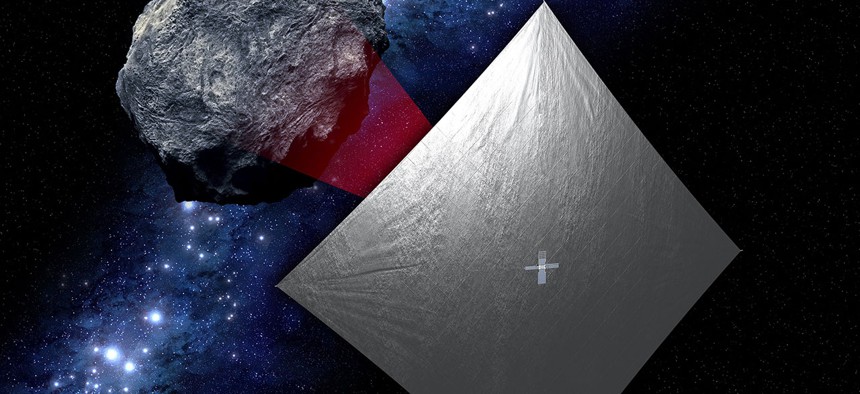
NASA illustration
It took NASA’s Voyager I probe 35 years to reach the edge of our solar system and enter interstellar space. But a lot has changed in space technology since Voyager launched in 1977. NASA’s new space sail—propelled only by the sun—can make that same trip in 20 years.
On Tuesday (Feb. 2), NASA announced that the Space Launch System—the rocket that replaced the space shuttle and will eventually send humans to Mars— will carry 13 small satellites (called CubeSats) on its inaugural flight in 2018. One of those satellites is the Near-Earth Asteroid (NEA) Scout , a space vessel that runs on light.
NEA Scout, whose solar technology some believe to be the future of space travel , is detailed in an excellent profile in National Geographic . The satellite’s initial destination is asteroid 1991 VG. It’ll do some recon on the asteroid’s size, movement, and composition, so that NASA is better prepared when the time comes to send humans there (or to similar asteroids).
Instead of a traditional, chemical propellant, it’s powered by photons from the sun pelting its ultrathin sail, which is about the size of a school bus. The sail is made of plastic with aluminum coating, and is as thin as a single strand of human hair . According to National Geographic , it’ll fly up to speeds of 63,975 miles per hour (28.6 kilometers per second).
The trip to 1991 VG is just a fraction of the distance a spacecraft like NEA Scout is capable of traveling. “In the future, solar sails can take spacecraft to the outermost regions of the solar system faster than ever before,” said Les Johnson, NEA Scout’s solar sail principal investigator, on NASA’s website .
Normal propellants slowly burn up during long journeys, causing the spacecraft to slow down. Solar sails, however, don’t have that problem—the sun never stops shining.
“A sail wins the race in terms of final velocity because it’s the tortoise and the hare,” Johnson told National Geographic . That means solar sails can travel extremely long distances relatively quickly. The catch is that its payload must be light for the spacecraft to accelerate, since its source of power (the sun) is constant.
The nonprofit research organization Planetary Society, led by scientist Bill Nye “The Science Guy,” is also developing solar sailing technology in its LightSail project. “We strongly believe this could be a big part of the future of interplanetary missions,” Nye told the New York Times (paywall) last year.
NASA is now investigating something called electric sails , or “e-sails.” Instead of a single solar sail, e-sails use several long, razor-thin coils that sprout from the center of the spacecraft. When charged particles in solar wind reach the spacecraft, they’re repelled by the electric field that the coils create—propelling the spacecraft forward.
E-sails can move up to 93 miles per second (150 km per second). At those speeds, an e-sail could reach the end of the solar system in just 10 years. Perhaps one day, they’ll sail far beyond that.






